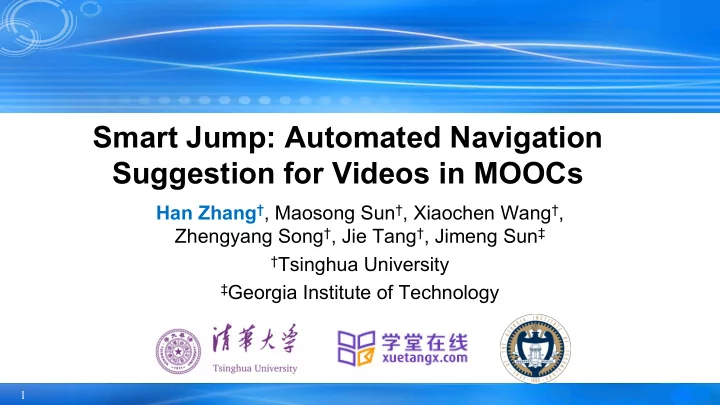

Smart Jump: Automated Navigation Suggestion for Videos in MOOCs Han Zhang † , Maosong Sun † , Xiaochen Wang † , Zhengyang Song † , Jie Tang † , Jimeng Sun ‡ † Tsinghua University ‡ Georgia Institute of Technology 1
MOOCs • 808 courses • 5,900,000 users 2
Jump Back: How much time, do you know? t t+8 5𝑇 According to what we have discussed we find that the fifth activity belongs to cash outflow of a business activity. 5𝑇×5000000 = 6944ℎ𝑝𝑣𝑠𝑡 (Users) 3
Multiple Jumping 1 2 3 4 5 2.6 clicks on average for a complete jumping back 4
Problem: Smart Jump Challenge 1: What are the underlying factors behind the jump? Jump-back Navigation Distribution Challenge 2: How to incorporate individual information for an accurate recommendation? 0.07 0.35 0.11 0.26 Personalized Suggestion Let’s begin with … First, we introduce … The example is that … Next … capital assets … investment property … Automated suggestion for video navigation 5
Complete-jump Complete-jump construction base on DFA Two basic complete-jump patterns 6
Observations – Video Related • Jump span is positively correlated with the Most jumps are close to the diagonal length of videos. (~90% locate in the light blue area) • Complete-jumps with longer jump span are more easily to be affected by video length 7
Observations – Course Related Science courses contain Users in science courses are Users in non-science courses much more frequent jump- likely to rewind farther than jump back earlier than users in backs than non-science science courses. users in non-science courses. courses. 8
Observations – User Related • 6.6% users prefer 10 seconds • 9.2% users prefer 17 seconds • 6.6% users prefer 20 seconds 9
Video Segmentation 0 s In the next ninth economic activity The enterprise has paid 4,000,000 yuan What is the money used for Of which 2,500,000 yuan is paid for the expenditure of sales department 1,500,000 for the expenditure of administrative department 30 s …… • 𝑆 0_23 : rate of effective complete-jumps (start position and end position located in different segments). • 𝑆 4_5 : rate of non-empty segments (contains at least one start position or end position of some complete-jumps). 10
Problem Formulation …… S …… 𝑇 8 𝑇 𝑇 867 𝑇 3 367 11
Data Set • Science: Financial Analysis and Decision Making, Data Structure Principle of Circuits. • Non-science: Japanese Language and Culture the Aesthetics of Modern Life, Chinese Ancient Civilization Etiquette 12
Features One-hot representation of user id Basic features Start and end position of complete-jump Length of video in second Video Kth percentile of jump span in the video, K = 25, 50, 75, 90 Number of complete-jumps start from the position Start position Entropy of jump span Number of complete-jumps of the user User User category generated by k-means clustering 13
Experimental set – Negative Sample Construction …… S S …… 𝑇 𝑇 𝑇 𝑇 867 𝑇 8 369 367 3 We randomly select m (tunable parameter) end positions as negative samples 14
End Position Prediction Course Model Model AUC AUC Recall Recall Precision Precision F1-score F1-score LRC LRC 72.46 72.46 64.28 64.28 25.95 25.95 37.37 37.37 Science SVM SVM 71.92 71.92 64.06 64.06 25.45 25.45 36.42 36.42 FM FM 74.02 74.02 68.36 68.36 27.61 27.61 39.28 39.28 LRC LRC 72.59 72.59 72.96 72.96 69.23 69.23 70.69 70.69 Non-science SVM SVM 73.52 73.52 79.03 79.03 68.39 68.39 73.28 73.28 FM FM 73.57 73.57 79.82 79.82 67.56 67.56 72.88 72.88 15
End Position Ranking Course Method Method n = 1 n = 1 n = 2 n = 2 n = 3 n = 3 n = 5 n = 5 Baseline Baseline 33.21 33.21 53.21 53.21 66.15 66.15 81.99 81.99 Science FM FM 37.05 37.05 60.40 60.40 76.04 76.04 89.59 89.59 Baseline Baseline 39.26 39.26 62.61 62.61 76.64 76.64 91.30 91.30 Non-science FM FM 42.25 42.25 72.42 72.42 88.43 88.43 96.05 96.05 • Hits@n to evaluate the ranking performance • Baseline method is based on navigation distribution of all users • Our method based on FM outperforms baseline over ~10% 16
Feature Contribution Ignoring each category of features • Each category of features contributes improvement in the performance • Our method works well by combining different features 17
Summary • We formally define an interesting problem of automated navigation suggestion in MOOCs, and systematically study the problem on a real large MOOC dataset. • We reveal several interesting phenomena about jump-back behaviors. • We propose a method to predict users’ jump-back behaviors. 18
Future Research • Explore more factors that have influence on video navigation, like user location, visual information, etc. • Take account of dynamic information, like the behaviors just before a jump-back. • Design a better predictive model with higher accuracy 19
Thank you ! Collaborators: Jie Tang, Maosong Sun, Xiaochen Wang, Zhengyang Song ( THU ) Jimeng Sun ( Gatech ) 20
Recommend
More recommend